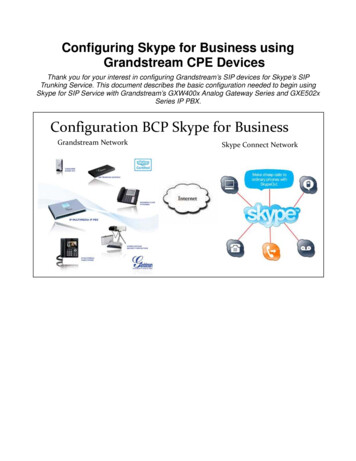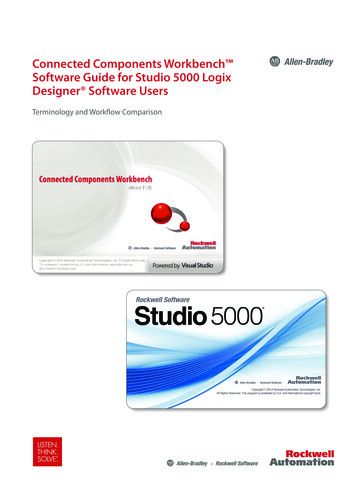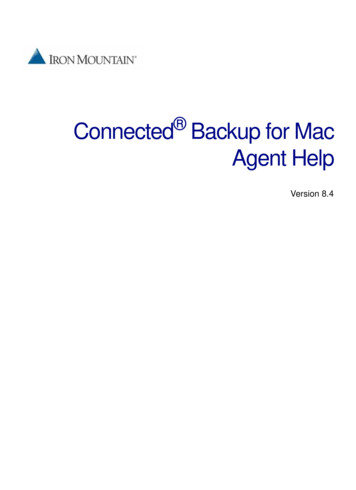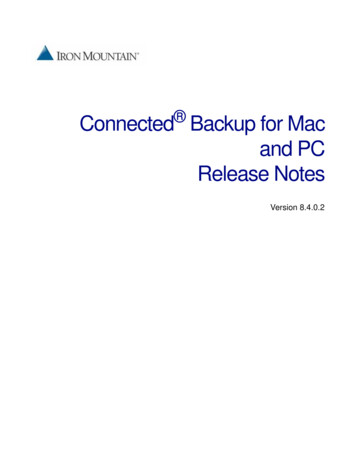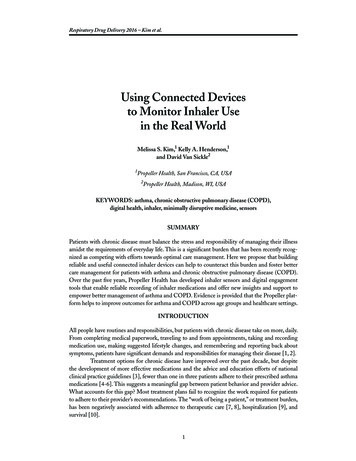
Transcription
Respiratory Drug Delivery 2016 – Kim et al.Using Connected Devicesto Monitor Inhaler Usein the Real WorldMelissa S. Kim,1 Kelly A. Henderson,1and David Van Sickle21Propeller Health, San Francisco, CA, USA2Propeller Health, Madison, WI, USAKEYWORDS: asthma, chronic obstructive pulmonary disease (COPD),digital health, inhaler, minimally disruptive medicine, sensorsSUMMARYPatients with chronic disease must balance the stress and responsibility of managing their illnessamidst the requirements of everyday life. This is a significant burden that has been recently recognized as competing with efforts towards optimal care management. Here we propose that buildingreliable and useful connected inhaler devices can help to counteract this burden and foster bettercare management for patients with asthma and chronic obstructive pulmonary disease (COPD).Over the past five years, Propeller Health has developed inhaler sensors and digital engagementtools that enable reliable recording of inhaler medications and offer new insights and support toempower better management of asthma and COPD. Evidence is provided that the Propeller platform helps to improve outcomes for asthma and COPD across age groups and healthcare settings.INTRODUCTIONAll people have routines and responsibilities, but patients with chronic disease take on more, daily.From completing medical paperwork, traveling to and from appointments, taking and recordingmedication use, making suggested lifestyle changes, and remembering and reporting back aboutsymptoms, patients have significant demands and responsibilities for managing their disease [1, 2].Treatment options for chronic disease have improved over the past decade, but despitethe development of more effective medications and the advice and education efforts of nationalclinical practice guidelines [3], fewer than one in three patients adhere to their prescribed asthmamedications [4-6]. This suggests a meaningful gap between patient behavior and provider advice.What accounts for this gap? Most treatment plans fail to recognize the work required for patientsto adhere to their provider’s recommendations. The “work of being a patient,” or treatment burden,has been negatively associated with adherence to therapeutic care [7, 8], hospitalization [9], andsurvival [10].1
2Using Connected Devices to Monitor Inhaler Use in the Real World – Kim et al.In order to better incorporate the real world circumstances of patients’ lives into treatmentregimens and subsequently improve patient care and outcomes, researchers have developed aframework called minimally disruptive medicine (MDM). MDM acknowledges the daily burdenon both patients and caregivers required to manage chronic disease, and calls for fitting the overalltherapeutic approach into the context of a patient’s life [11]. It highlights limitations – such asinadequate communication and coordination – across health care and in provider-patient relationships that add to treatment burden [12, 13]. MDM suggests that normalizing and integrating thepatient workload into daily life can improve adherence to therapy and calls for patients and theirphysicians to build pragmatic treatment plans that can be successful in the real world [14].We believe MDM provides a valid framework for characterizing many limitations to optimalcare for asthma and COPD. In this report, we use MDM to highlight the real world challengesthat Propeller Health aims to address through digital technology that not only helps to streamline self-management and encourage communication and support, but also attempt to strengthenpatient-provider relationships to accomplish the goals of therapy.Propeller Health Provides a Comprehensive Solution for Meeting Goals of MDMFounded in 2010, Propeller Health is the leading digital health solution for respiratory medicine.Propeller aims to provide better engagement, communication, and more insightful and personalized care. Through a combination of inhaler device sensors, mobile applications, analytics, andregular feedback, the Propeller platform is designed to reduce the stress and burden of diseasemanagement. Propeller starts by creating a custom view of each patient, allowing patients and caregivers to better understand the impact and management of their disease in daily life. This includespassive tracking of when and where each patient is using their inhaler medications. Remindersare sent to each patient to keep them on track with prescribed dosing instructions. Running inthe background, our analytics platform helps to identify moments or patterns that patients, carecoordinators, and caregivers want to know about such as asthma attacks or signals of worsening.Propeller provides personalized alerts about these events, providing an opportunity to intervene,change behavior, and improve outcomes.Propeller Health has received FDA510(k) class II clearance to measure and improvemedication adherence, predict exacerbations, andhelp reduce the frequency of symptoms and exacerbations in asthma and COPD. Propeller’splatform has been clinically validated in tworandomized controlled trials and more than tenclinical studies involving over 1,400 patients. Ithas been used by patients in over 35 commercialprograms across the United States, includingmajor healthcare systems, payers, employers, andother commercial partners. Propeller’s platform iscompatible with the majority of commonly usedasthma and COPD inhalers, including meteredFigure 1. Propeller MDI sensor and user app.dose inhalers (MDIs), and other inhaler devices
Respiratory Drug Delivery 2016 – Kim et al.3(dry powder inhaler (DPI) and soft mist inhaler (SMI)). It works with controller medications suchas GlaxoSmithKline’s (GSK) Flovent , Merck’s Dulera , Teva’s QVAR , and others, as well as reliever medications such as GSK’s Ventolin HFA, Merck’s Proventil HFA, Teva’s ProAir HFA,generic albuterol metered dose inhalers (MDIs), as well as GSK’s Diskus DPI, and BoehringerIngelheim’s SMI.We aim to summarize three ways that Propeller Health bridges issues articulated by MDMand encourages better management of asthma and COPD. First, we describe how Propeller’s sensors are built to accurately and reliably monitor multiple inhaler delivery devices, and how we havedesigned the strategy required to surround patients with supportive digital interfaces and experiences in asthma and COPD. Then, we share important lessons from usability studies and surveysthat led to product improvements and greater patient engagement over time. Finally, we provide asummary of clinical outcomes from our commercial programs that demonstrate user engagementand improved outcomes across patient demographics (age groups) and healthcare settings.Building Accurate and Reliable Sensors for Inhaler DevicesThe addition of electronics to an inhaler can compromise what is elegant about its design. Durableand robust, they carry large supplies of medication in a small and pocketable form and deliver precise amounts with each simple use. They are unique among our devices today in their disdain forelectricity. And, in some cases, they are even resistant to water.Couple that with the variety of marketed inhaler devices and the range of active ingredientsand you find yourself with a significant set of challenges to the design and engineering of add-onsensors. Each has to be built to accurately and reliably record the specific pairing of medicationand device, to accommodate diverse patterns of use, and to operate with negligible impact on theday-to-day life of people with chronic respiratory disease. In this section, we review some of theimportant lessons we have learned while building sensors for the inhaled medications and patternsof use today.Inhaled medications need to fit into the lifestyle of the patients who use them. For example,inhaled rescue medications such as an albuterol MDI need to be readily available at all times so thatthey can be used to relieve symptoms if and when they occur. Most of the time, the inhaler is storedin a pocket, backpack, or a glove compartment. By contrast, inhaled steroids are typically stored inthe home, and are available for use in the morning and night. How these inhalers are stored andused plays a direct role in the decisions about industrial designs and electronic components for sensors. Where similar devices, such as MDIs, can deliver both types of medications, add-on sensorsdesigned to monitor the use of MDIs must be adaptable to both types of medication and use.Add-on sensors must be discreet and unobtrusive. Already complex delivery systems,attachment of the sensor should not make the inhaler harder to use, nor negatively affect activationof the device, or the integrity of the delivered dose. Where the inhaler has a dose counter, it shouldremain visible to patients; even labels and branding can be commercially important. The enclosuresof many of our add-on devices use a transparent material to provide ready access to these features.Neither can the device change how a person uses their inhaler, or demand much attention and upkeep. At Propeller Health, we work to make add-on sensors that can remain as passive as possible– asking no participation on the part of the patient beyond some minimal initial setup.Copyright 2016 VCU
4Using Connected Devices to Monitor Inhaler Use in the Real World – Kim et al.Nothing compares to the experience Propeller Health has gained from instrumentingmedications and witnessing how these sensors work in the real world setting. Sometime this teachesus about miscalculations. Propeller’s initial sensors for MDIs were designed to be recharged oncea month. Despite what we considered to be a generous battery life, we have found that recharging –even at this interval – presented an obstacle to ongoing use of the sensor. We now recognize thatthe general public had begun to build daily habits around recharging their smartphones, and themonth-long intervals between charging limited our ability to build a similar habit. Over the intervening years, improvements in the size and efficiency of electronic components, including batteries,together with advances in low-energy radios and protocols, have allowed us to build sensors nowthat are significantly smaller than our original device, yet last for more than a year without everneeding to be recharged.Propeller Health also recognized that sensors should be compatible with a wide range ofthe medications on the market. While we started with an MDI sensor, we have recently built andreceived FDA clearance for add-on sensors for DPIs and SMIs. In general, these devices can bemore complicated to use. For example, unlike an MDI, these inhalers may have covers that slideout of the way, or that must be primed before inhalation. While the MDI sensor can be built witha mechanical switch, these types of inhalers require more elaborate and coordinated sensing andelectronic processing to understand when the medication is being handled, prepared, and used. Asa result, our add-on devices employ a set of sensors and electronics to detect actuation of the inhalerthrough a variety of means but with each additional piece we have to balance the incremental costs– both economic and electric – of the components against its marginal value.When attached to regular anti-inflammatory medication, Propeller’s inhaler sensors provideaudiovisual reminders that alert the patient when to take the next dose. These reminders, whichsignal a missed dose, have been shown to improve adherence in a number of trials [15-17]. Thesetypes of reminders join other electronic notifications, such as emails and text messages, in helpingto encourage more regular and appropriate use of anti-inflammatory medication over time.User Feedback Has Driven Product ImprovementPropeller Health is constantly iterating to improve the sensors and platform and optimize thepatient experience. Upon completion of studies and programs, patients are asked to answer surveyquestions on a Likert scale about their experience and satisfaction using Propeller. Patients froma few recent programs were surveyed and 80% reported the platform was easy to use (n 127) and94% were satisfied with the information that they received (n 101). Patients cited Propeller’s medication reminders, insights on triggers, and medication use trends as particularly useful for their selfmanagement. COPD patients have reported similar levels of satisfaction as in our asthma programs.Through talking with patients, we have learned which features provide the most value,preferences about frequency and communication style, and how the information is used with providers. Patients have shared how helpful the platform has been for identifying triggers that theyhad not known about before and how this new information has allowed them to be proactive inhow they use their medication. Other patients have found the educational pages valuable. Propellerhas received diverse feedback about the frequency of receiving email alerts and messages, whichdrove us to create an opportunity for individual users to customize how they would like to receiveour information.
Respiratory Drug Delivery 2016 – Kim et al.5Examples of useful feedback from users have included: “I feel more supported. The systemgives you a feeling of being more in control. It's sort of like having someone around you all the timewhose only job is to track your asthma.” We have also received feedback about how Propeller hasbeen useful for talking with doctors: “I didn't realize how much I was using my rescue [inhaler] andwhen I started seeing the emails [from Propeller], I was able to talk to my physician and discussthat I was actually less controlled than I thought.” Through talking with care managers, we foundout that the Propeller platform can save time on outreach calls. Care managers found that they wereable to have more meaningful and direct conversations about treatment and how to manage in dailylife. Multiple patients have shared that they print out email summaries produced by Propeller tobring to their doctor’s appointments and describe how useful that has been for talking with theirdoctor about how they have been feeling since their last visit. Propeller has learned that caregiversreceive information about their children or other family members with much greater ease. This hasbeen especially valuable for parents who are interested in getting the full picture of their child’s experience with asthma by having access to medication use and symptoms while the child is at school.Outcomes and Engagement Across Age Groups and Healthcare SettingsDoes Propeller solve for the problems defined by MDM? And is it suitable in all healthcare settings?Here we share clinical results and engagement by age and program type. Propeller’s experienceshows that we engage user groups across patient demographics and healthcare settings. We demonstrate important clinical outcomes such as reduction of asthma symptoms (rescue inhaler usedecrease) and improvement of control (% of participants with short-acting beta-agonist medication(SABA) use on 2 days/week*).We describe aggregated data for Propeller’s commercial programs. Across these programs,Propeller has enrolled asthma patients across a range of ages (2-90 years, mean 29.3, standard deviation 19.6). Table 1 shows that patients participated in Propeller through three distinct healthcaresettings: “Community” (community-oriented program without clinical integration and fundedthrough a grant), “Payer” (commercial health plans), or “Provider” (programs with healthcare providers). We highlight three outcome and engagement metrics in Table 1. A reduction of SABA useto less than two days per week is an important component and indicator of asthma control [5, 18].We include all person-days in the analysis and modeled data using mixed effects Poisson regression models with random intercepts, to account for the repeated observations for each person. Thepredictor was the number of days since each participant had started tracking rescue medicationuse with a Propeller sensor. The magnitude and statistical significance of this coefficient was theprimary result that was assessed.In a combined analysis, the quantity of rescue inhaler use decreased statistically significantly(p 0.0001) the longer each participant was in the program, suggesting improving asthma controlover time. These decreases were stable and durable over the course of one year of monitoring.Copyright 2016 VCU
6Using Connected Devices to Monitor Inhaler Use in the Real World – Kim et al.Table 1.Clinical results and engagement, by age and program type.Consistent results were seen in all subgroups and healthcare settings (Table 1). A substantialincrease in the percent of participants with 2 days/week of SABA uses in the community-basedprograms was notably lower than that seen in other program types, which was attributed to lessclinical oversight for enrollment and execution than other programs. Early results from employerbased programs showed similar results to those from other program types.The metric daily active user/monthly active user (DAU/MAU) is an important measureof patient engagement used by digital technologies across industries. Propeller’s DAU/MAU ratiois more than 70% across subgroups. In other words, we receive data from 70% patients every day.To put this in context, several smartphone and web-based games have a DAU/MAU between 20and 30%, and Facebook has a DAU/MAU of 70%.CONCLUSIONOver the past five years, Propeller has built technology and experience that empowers patients livingwith chronic respiratory disease. The company’s connected sensors and support platform meets theneeds of a wide range of users and care settings. We have listened to patient and provider experience to fuel product development in a way that easily fits into patients’ lives. The result (simpleinterfaces, custom insights, and meaningful real-time data) is improved outcomes for a wide varietyof asthma and COPD patients across the healthcare spectrum.ACKNOWLEDGEMENTSPropeller Health would like to acknowledge the patients and caregivers that have provided feedback over the last several years. This feedback has helped us to iterate and improve so that we canbetter help those with chronic respiratory disease.
7Respiratory Drug Delivery 2016 – Kim et al.REFERENCES1.Gallacher K, Morrison D, Jani B, Macdonald S, May CR, Montori VM, Erwin PJ, Batty GD,Eton DT, Langhorne P, Mair FS: Uncovering treatment burden as a key concept for strokecare: A systematic review of qualitative research. PLoS Med 2013, 10(6): e1001473.2.Eton DT, Ridgeway JL, Egginton JS, Tiedje K, Linzer M, Boehm DH, Poplau S, RamalhoOD, Odell L, Montori VM, May CR, Anderson RT: Finalizing a measurement frameworkfor the burden of treatment in complex patients with chronic conditions. Patient Relat OutcomeMeas 2015, 6: 117-26.3.National Asthma Education and Prevention Program (2007): Expert Panel Report 3: Guidelinesfor the diagnosis and management of asthma. US Department of Health and Human Services;National Institutes of Health; National Heart, Lung, and Blood Institute, Bethesda, MD.4.Barnes CB, Ulrik CS: Asthma and adherence to inhaled corticosteroids: Current status andfuture perspectives. Respir Care 2015, 60: 455-468.5.Williams LK, Peterson EL, Wells K, Campbell J, Wang M, Chowdhry VK, Walsh M,Enberg R, Lanfear DE, Pladevall M: A cluster-randomized trial to provide clinicians inhaledcorticosteroid adherence information for their patients with asthma. J Allergy Clin Immunol2010, 126(2): 225-31.6.Wu AC, Butler MG, Li L, Fung V, Kharbanda EO, Larkin EK, Vollmer WM, Miroshnik I,Davis RL, Lieu TA, Soumerai SB: Primary adherence to controller medications for asthma ispoor. Ann Am Thorac Soc 2015, 12: 161-66.7.Vijan S, Hayward RA, Ronis DL, Hofer TP: Brief report: The burden of diabetes therapy:Implications for the design of effective patient centered treatm
2 Using Connected Devices to Monitor Inhaler Use in the Real World – Kim et al. In order to better incorporate the real world circumstances of patients’ lives into treatment regimens and subsequently improv


